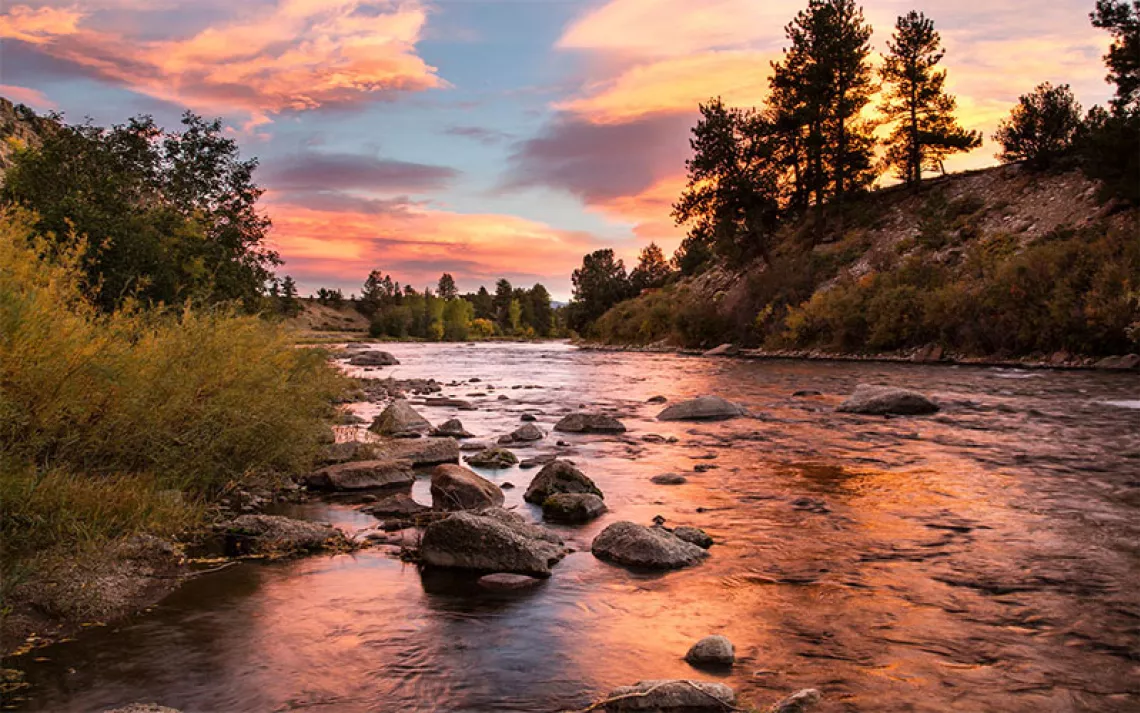The Zuni Lake Salt Woman and the Coal Mine
Lighting up Phoenix and Tucson could extinguish a Zuni deity

Zuni Salt Lake, New Mexico, where the Zuni have harvested salt for centuries. | Photo by Netherzone
The Zuni people call her Ma’l Oyattsik’i, the Salt Woman. For the moment she rests peacefully in her domain, a gentle refuge nestled among purple mesas, lush grasses, and tenacious trees. Zuni oral history tells how she used to live closer to the Zuni people, but grew angry with them and moved far away to Zuni Salt Lake, 50 miles south of the Zuni Pueblo in western New Mexico. For centuries, great pilgrimages have been undertaken by the men, not only of Zuni, but of neighboring Acoma Pueblo, the Navajo, the Apache, and others, to collect salt for their ceremonial life.
Hence A:shiwi A:wan Ma’k’yay’a dap an’ullapna Dek’ohannan Dehyakya Dehwanne, a 185,000-acre sanctuary surrounding the lake.
"Over there is the Zuni Trail," Zuni writer and historian Jim Enote tells me, gesturing toward a spot invisible to my eye. "The Apaches come in over there, the Navajo here. They would all pretty much respect each other in here, each staying in their own camps, even if they were fighting."
The trails to this place, explains Andrew Othole, a past Zuni lieutenant governor, "are umbilical cords tying the tribes to their salt deity and tying the sacred salt lake to the tribes’ other holy places." Softly trodden paths, traversed for millennia, remain today as vibrant a part of traditional cultures as they were in the past.
The lake is a miracle in itself, a spring-fed body of water in an arid landscape, seldom more than four feet deep, with a cone of salt rising in the middle. Salt from deposits around the shores is harvested by the tribes’ spiritual leaders; it is known as the flesh of the Salt Woman. The Pueblo and Navajo people use it in rituals when an infant first cries and smiles. It is the salt that nourishes life.

Sign up to receive Sierra News & Views
Get articles like this one sent directly to your inbox weekly.
With this action you affirm you want to receive Sierra Club communications and may vote on policy designated by the Sierra Club Board.
The Salt Woman is now threatened by an approaching network of mines, power plants, and power lines. The Salt River Project, the nation’s third-largest public utility, is running out of coal from the McKinley mine near Gallup, New Mexico, and is seeking to open an 18,000-acre strip mine at Fence Lake, ten miles from Zuni Salt Lake. To settle its coal dust, the Salt River Project plans to pump 85 gallons of water a minute for the 40 years of the mine’s planned operation—and has the legal right to pump ten times as much.
That draw on desert aquifers, Zunis fear, may dry up spring-fed Salt Lake. "There’s a strong hydrological connection between the aquifer that the coal mine wants to tap into and Zuni Salt Lake," says Malcolm Bowekaty, governor of the Zuni Pueblo. "When they vent a lot of pressure that’s forcing the water up, we will no longer have the salt."
"A lot of Native Americans, I don’t know what they would do," says Zuni tribal ranger Stanley Pinto. "They wouldn’t be able to do any of the things they need to do with the salt."
Despite the Zuni Pueblo’s long historical connection with the sacred lake, it has struggled for decades to win control of it. In the 19th century, explains Zuni attorney Paul Bloom, "Zuni Salt Lake had been put under the control of the territorial land commissioner rather than of the tribes. It was only in 1977 that Congress instructed the secretary of the Interior to arrange whatever land exchanges were necessary to return the land." It took until 1986 for Zuni Salt Lake and its shoreline to be transferred back to the Zuni Tribe, where the land was once again designated a "neutral zone" for continued use by all Native people in the region.
The federal government, in its own way, belatedly acknowledged the significance of the area in 1999, when the National Park Service recognized the 185,000 acres surrounding the lake as eligible for listing on the National Register of Historic Places. That, however, did not stop the mining proposal, nor have the more than 550 documented graves and archaeological sites in the proposed coal-mining area, nor the 50 sites along the proposed 44-mile rail line that would send the coal to the Coronado Generating Station in St. Johns, Arizona. The rail line would transect the pilgrimage trails used by the Zuni, Navajo, Hopi, Acoma, and Laguna people. The company has offered to "mitigate" the desecration with strategic culverts, so that the pilgrimages might continue without traversing the rail line.
Over the tribes’ strenuous objections, New Mexico gave the Salt River Project a permit to operate the mine in 1996. Its federal application languished during the Clinton administration, but was approved by George W. Bush’s Interior Department at the end of May. The department did attach the condition that the mine be prohibited from pumping water from the Dakota aquifer, which has been shown to be connected to Zuni Salt Lake, although it might pump from two others. Kirk Bemis, the Zunis’ hydrologist, says that the appropriate studies on these other aquifers have yet to be done. "Unless you prove that it’s not connected," he says, "we’re going to assume that it is." The tribe attempted to negotiate with the utility, to no avail, and is now vowing to fight the proposal in federal court.
The Zunis are a tough people. They have lived for centuries in some of the most trying terrain on Earth, and have made it flourish. When something has been taken from them, they have worked to recover it. For instance, Edward Wemytewa, the Zuni cultural wetland coordinator, describes the restoration of tribal lands about an hour’s drive west of Zuni Salt Lake near St. Johns: "That area is one of our sacred sites; it was once lush, but the river was diverted and died out. We finally got it back, and now we are restoring the wetlands."
Religious freedom is a popular doctrine in the United States, except as it applies to the First Nations of this country. It took until 1978, almost 200 years after the Constitution guaranteed freedom of religion for most Americans, for Congress to pass the American Indian Religious Freedom Act and President Carter to sign it into law. The act makes it "the policy of the United States to protect and preserve for American Indians their inherent right of freedom to believe, express, and exercise the traditional religions . . . including but not limited to access to sites, use and possession of sacred objects, and the freedom to worship through ceremonials and traditional rites." In 1996, President Clinton ordered that "each executive branch agency with statutory or administrative responsibility for the management of federal lands shall . . . avoid adversely affecting the physical integrity of such sacred sites." While neither the act nor Clinton’s executive order have been revoked or amended, the Bush administration and secretary of the Interior Gale Norton have simply ignored them.
In July, Zuni governor Bowekaty and others testified before the Senate’s Committee on Indian Affairs. "Zuni Salt Lake is in real danger of disappearing," said Bowekaty. "The Zuni tribe feels that the U.S. Department of Interior has failed us in its obligation . . . to protect this sacred lake and associated cultural resources from destruction." He mentioned in particular the many burial sites that will inevitably be desecrated by the Fence Lake strip mine: "Needless to say, the Zuni tribe finds it impossible to rationalize the displacement of our ancestors’ burials for the sake of making money."
"We have to start thinking in the traditional way," muses Zuni council member Arden Kucate. "It is not the earth, it is Mother Earth. Zuni people will not sacrifice our Salt Woman for cheap coal to serve Arizona or California, because she is irreplaceable."
New Mexico has been in the midst of a major drought. "That should be a message as to why we should protect the water resources," says Wemytewa. "When Zuni Salt Woman got angry and left, she taught us a lesson. We should learn from that. We can’t afford to lose any of the water. When it’s gone, it’s gone."
 The Magazine of The Sierra Club
The Magazine of The Sierra Club



